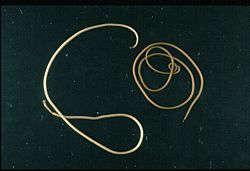Nematomorpha facts for kids
Quick facts for kids Nematomorpha |
|
|---|---|
 |
|
| Paragordius tricuspidatus | |
| Scientific classification | |
| Domain: | |
| Kingdom: | |
| (unranked): | |
| (unranked): |
Nematoida
|
| Phylum: |
Nematomorpha
Vejdovsky, 1886
|
| Classes | |
|
Nectonematoida |
|
The Nematomorpha, often called horsehair worms, are a group of animals that live as parasites. They look a lot like nematode worms and live in similar places, which is why their names sound alike. Sometimes people also call them Gordiacea.
These worms can be quite long, usually from 50 to 100 centimeters (about 20 to 40 inches). Some can even grow up to 2 meters (over 6 feet) long! But they are very thin, only about 1 to 3 millimeters wide. You can find horsehair worms in wet spots like watering troughs, streams, puddles, and cisterns.
Scientists know about 326 different kinds of horsehair worms, but they think there might be around 2000 species all over the world. Old horsehair worms have been found as fossils in amber from about 100 to 110 million years ago.
Contents
Life cycle
Adult horsehair worms live freely, meaning they don't need a host. In places like North America, you usually find them in or near shallow water during the summer months.
Larval stage and first hosts
The young worms, called larvae, live as parasites inside arthropods. These arthropods include beetles, cockroaches, grasshoppers, and crickets. These are their "final hosts." Since these hosts don't live in water, the horsehair worm's life cycle has an extra step.
Mating and eggs
A day or two after leaving their hosts, adult worms mate in the water. Around mid-August or mid-October, they lay their eggs in the water. It takes about a month for the larvae to grow inside these eggs.
Intermediate hosts
Once the larvae hatch, they somehow get into other animals. These can be gastropods (like snails and slugs), insects, or earthworms, which all live in damp places. Inside these animals, the larvae build a protective cyst and start to grow. The animal they grow inside is called an "interim" or temporary host. This is because the worm still needs a final host to complete its life cycle.
Final hosts and behavior control
Later, the developing horsehair worms are found inside their final hosts, like beetles. It's not fully clear how they get there, but it's likely that the final host eats the interim host, which has the worm larvae inside. Once they are in the final host, the horsehair worms begin to feed on it from the inside.
Interestingly, the horsehair worm can sometimes control its host's behavior. It might make the host move towards water and even jump into it! Then, the worm breaks out of the beetle in or near the water. Once free, it can find other worms and mate, starting the cycle all over again.
Images for kids
See also
 In Spanish: Nematomorpha para niños
In Spanish: Nematomorpha para niños


